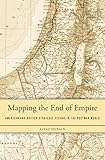Mapping the End of Empire : American and British Strategic Visions in the Postwar World / Aiyaz Husain.
Material type: TextPublisher: Cambridge, MA : Harvard University Press, [2014]Copyright date: ©2014Description: 1 online resource (384 p.) : 6 halftonesContent type:
TextPublisher: Cambridge, MA : Harvard University Press, [2014]Copyright date: ©2014Description: 1 online resource (384 p.) : 6 halftonesContent type: - 9780674728882
- 9780674419438
- 956.04
- DS63
- online - DeGruyter
- Issued also in print.
| Item type | Current library | Call number | URL | Status | Notes | Barcode | |
|---|---|---|---|---|---|---|---|
 eBook
eBook
|
Biblioteca "Angelicum" Pont. Univ. S.Tommaso d'Aquino Nuvola online | online - DeGruyter (Browse shelf(Opens below)) | Online access | Not for loan (Accesso limitato) | Accesso per gli utenti autorizzati / Access for authorized users | (dgr)9780674419438 |
Browsing Biblioteca "Angelicum" Pont. Univ. S.Tommaso d'Aquino shelves, Shelving location: Nuvola online Close shelf browser (Hides shelf browser)

|

|

|

|

|

|

|
||
| online - DeGruyter Midrash, Mishnah, and Gemara : The Jewish Predilection for Justified Law / | online - DeGruyter Lines of Descent : W. E. B. Du Bois and the Emergence of Identity / | online - DeGruyter Malthus : The Life and Legacies of an Untimely Prophet / | online - DeGruyter Mapping the End of Empire : American and British Strategic Visions in the Postwar World / | online - DeGruyter Metaphor / | online - DeGruyter Philosophy of Mathematics in the Twentieth Century : Selected Essays / | online - DeGruyter Progressive Inequality : Rich and Poor in New York, 1890-1920 / |
Frontmatter -- Contents -- Introduction -- 1 All of Palestine -- 2 Remapping Zion -- 3 The Contested Valley -- 4 Keystone of the Strategic Arch -- 5 Imperial Residues -- 6 Two Visions of the Postwar World -- 7 Maps, Ideas, and Geopolitics -- 8 Joining the Community of Nations -- 9 From Imagined to Real Borders -- Conclusion -- Abbreviations -- Notes -- Archives Consulted -- Acknowledgments -- Index
restricted access online access with authorization star
http://purl.org/coar/access_right/c_16ec
By the end of World War II, strategists in Washington and London looked ahead to a new era in which the United States shouldered global responsibilities and Britain concentrated its regional interests more narrowly. The two powers also viewed the Muslim world through very different lenses. Mapping the End of Empire reveals how Anglo-American perceptions of geography shaped postcolonial futures from the Middle East to South Asia. Aiyaz Husain shows that American and British postwar strategy drew on popular notions of geography as well as academic and military knowledge. Once codified in maps and memoranda, these perspectives became foundations of foreign policy. In South Asia, American officials envisioned an independent Pakistan blocking Soviet influence, an objective that outweighed other considerations in the contested Kashmir region. Shoring up Pakistan meshed perfectly with British hopes for a quiescent Indian subcontinent once partition became inevitable. But serious differences with Britain arose over America's support for the new state of Israel. Viewing the Mediterranean as a European lake of sorts, U.S. officials--even in parts of the State Department--linked Palestine with Europe, deeming it a perfectly logical destination for Jewish refugees. But British strategists feared that the installation of a Jewish state in Palestine could incite Muslim ire from one corner of the Islamic world to the other. As Husain makes clear, these perspectives also influenced the Dumbarton Oaks Conference and blueprints for the UN Security Council and shaped French and Dutch colonial fortunes in the Levant and the East Indies.
Issued also in print.
Mode of access: Internet via World Wide Web.
In English.
Description based on online resource; title from PDF title page (publisher's Web site, viewed 30. Aug 2021)


